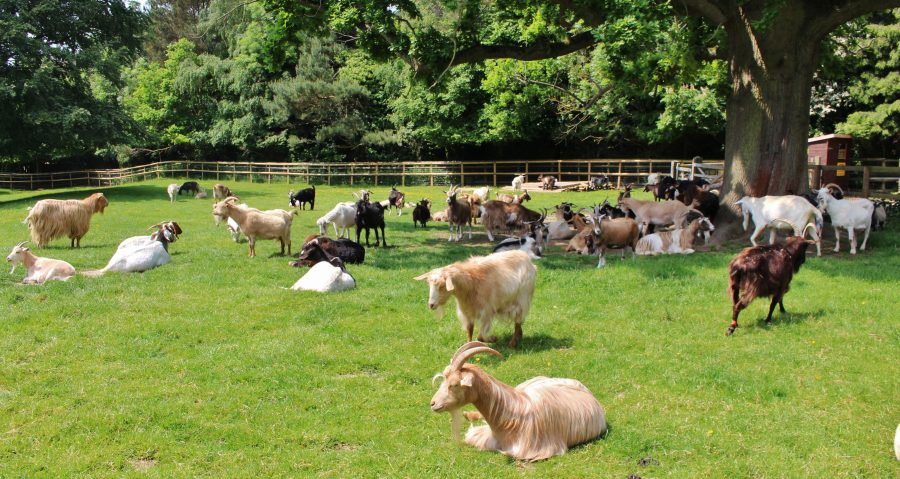Helen Babbs visits Buttercups Sanctuary for Goats in Kent – the UK’s only dedicated goat rescue centre…
Down a tree-lined lane in Kent is an unusual five acre smallholding that’s home to over a hundred goats. The paddocks are filled with a mixed herd of every breed of goat and every possible cross-breed, playing contentedly under the huge trees of what was once part of the deer park of a nearby stately home. What each goat shares is a background of suffering or homelessness, which has brought them to Buttercups Sanctuary for Goats.
FROM ONE GOAT TO MANY
“We’re the only specifically goat sanctuary in the UK,” explains Matt, the communications administrator at Buttercups. “We care for goats who’ve been abused or neglected, or in some cases, simply could no longer be kept by their former owners.”
The sanctuary provides both rescue and rehabilitation, and then a permanent rest-of-life home. Buttercups began in 1989, when rare-breed sheep keepers Bob and Valerie Hitch were asked by a friend at the local RSPCA if they could take in a goat who had just been rescued.
“Another couple of rescue goats soon followed, and then another, and then it kind of snowballed,” describes Matt. “People across the southeast began to contact us directly, if they saw a goat in trouble.”
By 2003, Buttercups shifted to a registered charity status, to ensure the work could continue long-term. “Sadly, there are always goats in need of rescuing,” Matt notes.
OUT IN THE FIELD
Whatever their sad beginnings, the goats at Buttercups are plainly happy now. With bright eyes and curious ears, the herd ranges across one of the two large paddocks that take up much of the holding. Each one is well-equipped as a goat playground, with several platforms and large logs to climb on, and the wide-spreading old trees to shelter under. The paddocks lead back to the goat sheds and hard standing area, where all-day hay is served up in long metal hay racks. Some livelier members of the herd also use the metal roofs of these as further climbing frames!
New arrivals move into a separate isolation area for two weeks, where they can receive any necessary medical attention, and grow accustomed to the rest of the herd at a distance. “Goats vary a lot in personality, and some recover faster than others.” The goats’ age is estimated at this point too, from the state of their teeth. “We can’t be precise, but at present our oldest is around 20 years old, and the youngest just 9 months.”
A DAY IN THE LIFE
The goats’ day begins with a concentrate breakfast at 8am, before they’re turned out onto the yard for their hay. “If the weather’s dry, they then go out onto the fields, which we swap between every three months,” Matt explains. “If it’s heavy rain, they have to stay in, but ideally they go out as much as possible. If they’ve been in for a ‘rain day’, there’s a lot of chasing about the moment they get outside!”
Bedtime arrives at sunset. “They come in off the field,” Matt describes with a chuckle, “then some of them go to bed in their loose boxes quietly – and the rest of them have a last half-hour romp, chasing all round the hay racks, wagging their tails and frisking and leading us a merry dance!”
Over-seeing this happy routine is the nine-strong team of Buttercups staff. “Three of us are office staff, and then there are six dedicated goat-keepers,” Matt explains. With backgrounds ranging from student work-placements who never left, to degrees in zoology, the staff all share a deep love of goats.
“I used to work in the day-to-day care of the goats,” says Matt, “and there are still three goats – Princess, Marmite and Daisy – who consider me their favourite human. They’ll bleat when they see me, and love coming over for a scratch and a cuddle.”
Helping with all the goat care, not to mention all the mucking-out, are over 50 volunteers from the local area. “Some people come for just a morning a week, others for several days. It’s quite a big team overall, but our supporters are what keep us going.”
For those not able to help in person, there’s an “Adopt-a-goat” scheme, or itemised donations that allow supporters to donate the cost of a bale of hay or sack of feed.
This article extract was taken from the Spring 2024 edition of The Country Smallholder. To read the article in full, you can buy the issue here.
To receive regular copies of The Country Smallholder magazine featuring more articles like this, subscribe here.
For FREE updates from the world of smallholding, sign up for The Country Smallholder newsletter here.








